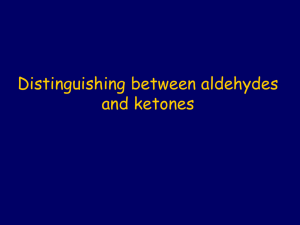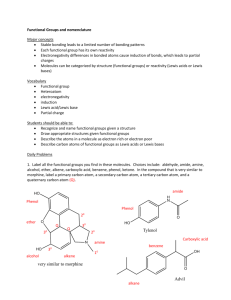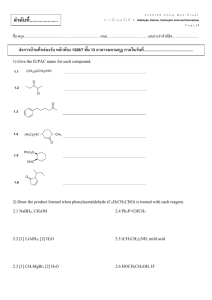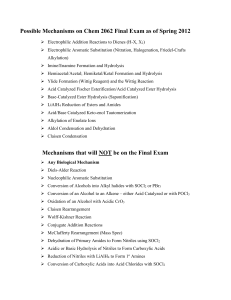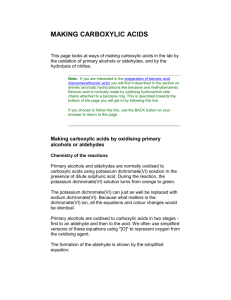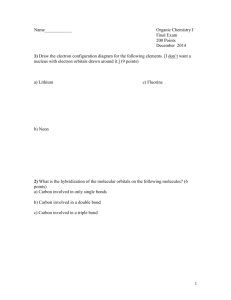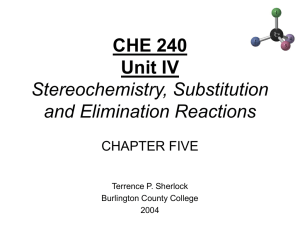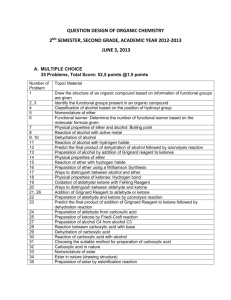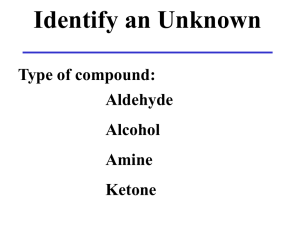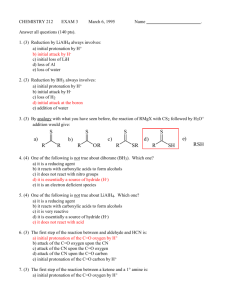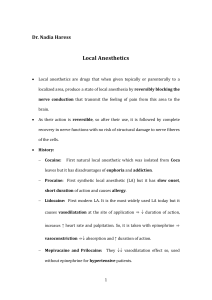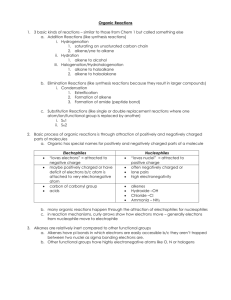Formative 3.5 2014
advertisement
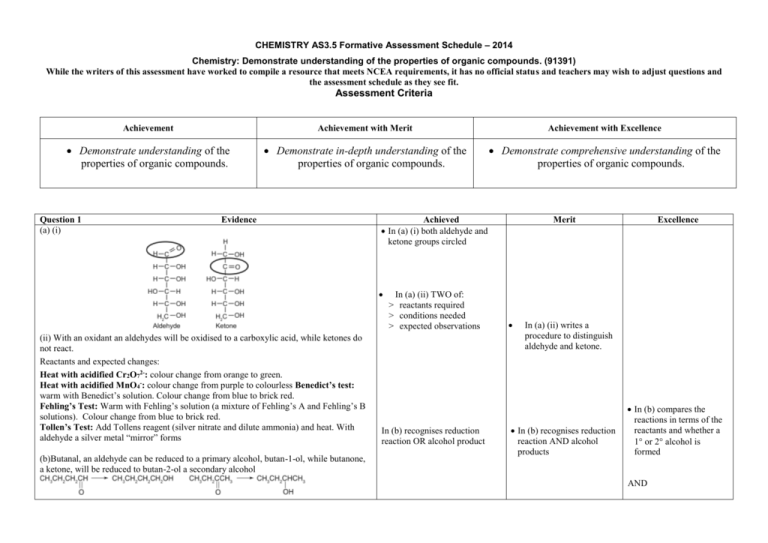
CHEMISTRY AS3.5 Formative Assessment Schedule – 2014 Chemistry: Demonstrate understanding of the properties of organic compounds. (91391) While the writers of this assessment have worked to compile a resource that meets NCEA requirements, it has no official status and teachers may wish to adjust questions and the assessment schedule as they see fit. Assessment Criteria Achievement Achievement with Merit Achievement with Excellence Demonstrate understanding of the properties of organic compounds. Demonstrate in-depth understanding of the properties of organic compounds. Demonstrate comprehensive understanding of the properties of organic compounds. Question 1 (a) (i) Evidence Achieved In (a) (i) both aldehyde and ketone groups circled (ii) With an oxidant an aldehydes will be oxidised to a carboxylic acid, while ketones do not react. Reactants and expected changes: Heat with acidified Cr2O72-: colour change from orange to green. Heat with acidified MnO4-: colour change from purple to colourless Benedict’s test: warm with Benedict’s solution. Colour change from blue to brick red. Fehling’s Test: Warm with Fehling’s solution (a mixture of Fehling’s A and Fehling’s B solutions). Colour change from blue to brick red. Tollen’s Test: Add Tollens reagent (silver nitrate and dilute ammonia) and heat. With aldehyde a silver metal “mirror” forms (b)Butanal, an aldehyde can be reduced to a primary alcohol, butan-1-ol, while butanone, a ketone, will be reduced to butan-2-ol a secondary alcohol In (a) (ii) TWO of: > reactants required > conditions needed > expected observations In (b) recognises reduction reaction OR alcohol product Merit Excellence In (a) (ii) writes a procedure to distinguish aldehyde and ketone. In (b) recognises reduction reaction AND alcohol products In (b) compares the reactions in terms of the reactants and whether a 1 or 2 alcohol is formed AND 2 (c) If a mix of Cr2O72- solution and pentan-1-ol is slowly fed from a separation funnel into hot dilute H2SO4, using equipment (i) (a flask connected to a Liebig condenser) ,the aldehyde formed is then quickly vapourised before it is oxidised into a carboxylic acid. It is then condensed so it runs down into the collection vessel. In (c) chooses one correct set of equipment linked to reaction required In(c) reasons for using the different equipment given In (c) a description given of how one set of equipment allows the reactions to proceed to their desired product. If pentan-1-ol is heated with an oxidising agent (e.g. H+/ Cr2O72-) under reflux using equipment ii (a bulb flask attached to a vertical Liebig condenser), pentanoic acid is obtained. The reaction is slower than the conversion to an aldehyde and to ensure conversion of all the alcohol into carboxylic acid, reflux is required to return any unreacted alcohol back into the reaction mixture so that it can react and form the acid. NØ N1 N2 A3 A4 M5 M6 E7 E8 No response or no relevant evidence. 1a 2a 3a 5a 2m 3m 1e with one minor error / minor omission / additional irrelevant information 1e In (c) links the equipment to the chemistry of the reactants and products. 3 Question 2 (a) Evidence Achieved In (a) 2 of the 3 names correct. Merit In (a) all names correct IUPAC systematic name Compound O H3C CH2CH2 C NH2 butanamide AND O H3C Excellence In (b) two named structures CH2 C propanoyl chloride Cl CH2 O H3C HC C CH3 O 2- methylpropyl ethanoate CH3 (b) Any ester with 6 carbons. Any 6 carbon carboxylic acid. (c) (i) Butan-1-ol reacts with concentrated H2SO4 to form but-1-ene and water. This is an elimination reaction. Since this is a primary alcohol with the –OH group at the end of the carbon chain there is only one possible product. Butan-2-ol is an unsymmetrical secondary alcohol so there are two ways the H2O can be eliminated forming but-1-ene and but-2-ene. But-2-ene is the major product as the H eliminated is from the C with the least H atoms. In (b) one named structure or two structures are correct In (c) one type of reaction is correct In (c) (i) or (ii) reaction product/products are given In (c) (i) Recognises major and minor products (ii) When ammonia reacts with propanoic acid, an acid-base reaction occurs A proton is transferred from the –COOH group to the NH3.to form a salt, ammonium propanoate (CH3 CH2COONH4) (If heat is applied a substitution reaction occurs resulting in an amide). CH3 CH2COOH + NH3 CH3 CH2COONH4 When ammonia reacts with propanoyl chloride, a substitution reaction occurs where NH 2 is substituted for the chlorine forming an amide (propanamide) CH3 CH2COCl + 2NH3 CH3 CH2CONH2 + NH4Cl In (b) two named structures are correct In (c) (i) recognises elimination reaction and the different products formed but reasons not adequate In (c) (ii) one reaction with NH3 is correct n with products and reason for one reaction OR both reactions correctly identified but discussion incomplete. In (c) (i) and (ii) a full discussion comparing the types of reaction including reaction products and reasons for differences 4 NØ N1 N2 A3 A4 M5 M6 E7 E8 No response or no relevant evidence. 1a 2a 3a 5a 2m 3m 1e with one minor error / minor omission / additional irrelevant information 1e 5 Question 3 (a) (i) Evidence (ii) Amino acids can form polymers because at each end of the molecule is a functional group that can react with a functional group from neighbouring molecules. (b) To be able to form enantiomers a molecule must have a chiral atom – one to which four different groups are attached. This enables the formation of molecules which are non-superimposable mirror images of each other. Glycine does not have a chiral carbon atom as the second carbon has only 3 different groups attached Alanine has a chiral carbon. The second carbon atom has a hydrogen atom, a methyl group, a carboxylic acid group and an amino group. Hence it can form nonsuperinposable mirror images Achieved In (a) a correct peptide drawn OR peptide link correctly circled. In (a) (ii) identifies having both functional groups on one molecule as being necessary In (b) Links enantiomers to a chiral C (words or diagram) In (b) identifies differences stereochemistry of the amino acids In (c) any 3 requirements of the scheme correct. OR Polymer drawn correctly Merit In (a) a correct peptide drawn with link correctly circled AND recognises why amino acids can form polymers Excellence In (b) explains why alanine can form enantiomers and glycine cannot In (b) compares the structures of alanine and glycine and links them to the ability to form enantiomers (with diagrams) In (c) scheme completed with one error allowed (includes polymer) In (c) completes the reaction synthesis pathway (d) Under acidic hydrolysis conditions we get the diol and the dicarboxylic acid being formed when the ester bonds are broken. A water molecule is also formed. HO OH HO CH2 CH2 OH 6 In (d) states the different In (d) compares the sets of products for acid and for basic hydrolysis similarities of the acid and base hydrolysis products or contrasts their differences O O In basic hydrolysis conditions the carboxylic group would be ionised and the sodium salt of the acid is formed. Na O In (d) compares the similarities of the acid and base hydrolysis products and contrast their differences and link them to the conditions of the hydrolysis. O Na O O NØ N1 N2 A3 A4 M5 M6 E7 E8 No response or no relevant evidence. 1a 2a 4a 5a 2m 3m 2e 3e Judgement Statement Score range Not Achieved Achievement Achievement with Merit Achievement with Excellence 0–6 7 – 13 14 – 18 19 – 24
